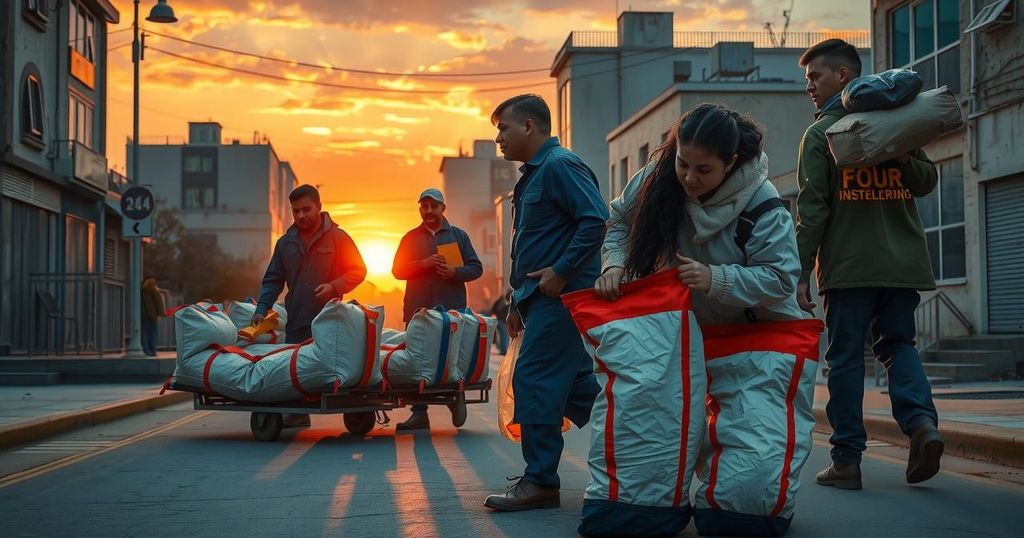World news
AFRICA, AL KATANTY, AMERICAN THINKER, CONGO, CONGO (KINSHASA), CYRIL RAMAPHOSA, DEMOCRATIC REPUBLIC OF CONGO, DJAFFAR AL KATANTY, DONALD TRUMP, DRC, GOMA, ICRC, JOHANNESBURG, MEDIA, MEDIA CRITICISM, NORTH AMERICA, OVAL OFFICE, POLITICS, REUTERS, SOCIAL MEDIA, SOUTH AFRICA, TRUMP, TRUMP ADMINISTRATION, U. S, UNITED STATES, WASHINGTON, WHITE HOUSE, YOUTUBE
Lena Nguyen
0 Comments
Trump Misidentifies Congo Footage as Evidence of Violence Against White Farmers
U.S. President Trump misrepresented a Reuters video, misidentifying gruesome footage from Congo as evidence of killings of white farmers in South Africa during a meeting with President Ramaphosa. The video showed humanitarian workers post-M23 rebel attacks, and the White House has not commented on the error. This incident reveals the dangers of misinformation in political discourse.
In a notable misrepresentation, U.S. President Donald Trump displayed a screenshot from a Reuters video, mislabeling it as evidence of white farmers being killed in South Africa. This incident transpired during a tense meeting with South African President Cyril Ramaphosa at the White House. Trump claimed, “These are all white farmers that are being buried,” while presenting the print-out of the article alongside the image.
However, the video, published on February 3 by Reuters, actually depicts humanitarian workers handling body bags in Goma, a city in the Democratic Republic of Congo. This footage was recorded after violent clashes involving Rwandan-backed M23 rebels, which significantly undermines Trump’s assertions about farm murders in South Africa.
The article shown to Ramaphosa originated from American Thinker, a conservative online outlet focusing on racial tensions in South Africa and Congo. Although the post included the video as a “YouTube screen grab” without appropriate captioning, it linked back to a Reuters news report documenting the turmoil in Congo. As of now, the White House has not responded to inquiries concerning this incident.
Andrea Widburg, managing editor of American Thinker, acknowledged that Trump had incorrectly identified the image. Despite this, she pointed to the pressures faced by white South Africans under what she described as Ramaphosa’s “dysfunctional, race-obsessed Marxist government.”
The Reuters footage, taken by journalist Djaffar Al Katanty, illustrated a mass burial following M23 attacks, illustrating the humanitarian crisis faced in that region. Al Katanty expressed his surprise at discovering that Trump had used his image to promote an unfounded narrative regarding racial violence in South Africa. “In view of all the world, President Trump used my image, used what I filmed in DRC to try to convince President Ramaphosa that in his country, white people are being killed by Black people,” Al Katanty stated.
Ramaphosa’s visit to the U.S. aimed to improve relations amid ongoing scrutiny and criticism from Trump. The South African president has faced allegations concerning land reform policies and treatment of the nation’s white minority, which the South African government has consistently refuted. During the meeting, Trump played a video, claiming it showcased genocide against white farmers in South Africa. This theory, propagated in certain far-right circles, lacks credible evidence.
As Trump continued to present printed articles detailing alleged murders of white South Africans, he repeated alarming descriptors like “death, death, death, horrible death.” This conflation of unrelated events underlines the ongoing tension and misinformation surrounding racial issues in South Africa, and it raises concerns about the impact of such rhetoric on international relations.
The entire episode underscores not just miscommunication but also how inaccurate information can be leveraged to reinforce divisive narratives. Addressing the factual discrepancies surrounding these claims is essential to fostering a more informed dialogue about racial dynamics in South Africa and beyond.
In summary, President Trump’s misrepresentation of a Reuters video as evidence of rampant violence against white farmers in South Africa highlights significant issues surrounding misinformation and its implications in international politics. The footage he used actually depicts a humanitarian crisis in the Democratic Republic of Congo, a fact confirmed by Reuters. This incident illustrates a concerning trend of conflating unrelated events and perpetuating divisive myths, which can strain diplomatic relationships.
Original Source: www.straitstimes.com




Post Comment